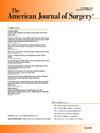Extra-abdominal CT imaging indicates increased severity of illness in advanced age patients requiring emergency abdominal surgery
IF 2.7
3区 医学
Q1 SURGERY
引用次数: 0
Abstract
Background
Abdominal sepsis frequently causes neurologic and pulmonary dysfunction among geriatric patients, We hypothesize that patients with abdominal sepsis who undergo extra-abdominal imaging have a greater burden of illness.
Methods
Patients 65 years and older that underwent emergency abdominal surgery for sepsis were divided into those with abdominal only(AbdCT) versus abdominal and extra-abdominal(ExtraCT) imaging.
Results
ExtraCT patients(N = 30) compared to AbdCT(N = 97) had higher rates of dementia(13.3 % versus 3.3 %; p = 0.03), diabetes(93.3 % versus 60.1 %; p < 0.01 and COPD(70 % versus 29.9 %; p < 0.01) but lower rates of abdominal pain as chief complaint (23.3 % versus 81.4 %; p < 0.01) and higher rates of being qSOFA positive (33.3 % vs 7.2 %; p < 0.05). Importantly, time to OR was not different between groups. ExtraCT patients had higher rates of 30-day mortality (33.3 % vs 5.2 %; p < 0.01). Extra-abdominal CT imaging was associated with increased risk of mortality (OR = 5.4; 95 %CI = 1.4–20.1).
Conclusions
ExtraCT among geriatric patients with abdominal emergencies is a marker of severity of illness and should guide end-of-life decision making.
求助全文
约1分钟内获得全文
求助全文
来源期刊
CiteScore
5.00
自引率
6.70%
发文量
570
审稿时长
56 days
期刊介绍:
The American Journal of Surgery® is a peer-reviewed journal designed for the general surgeon who performs abdominal, cancer, vascular, head and neck, breast, colorectal, and other forms of surgery. AJS is the official journal of 7 major surgical societies* and publishes their official papers as well as independently submitted clinical studies, editorials, reviews, brief reports, correspondence and book reviews.

 求助内容:
求助内容: 应助结果提醒方式:
应助结果提醒方式:


